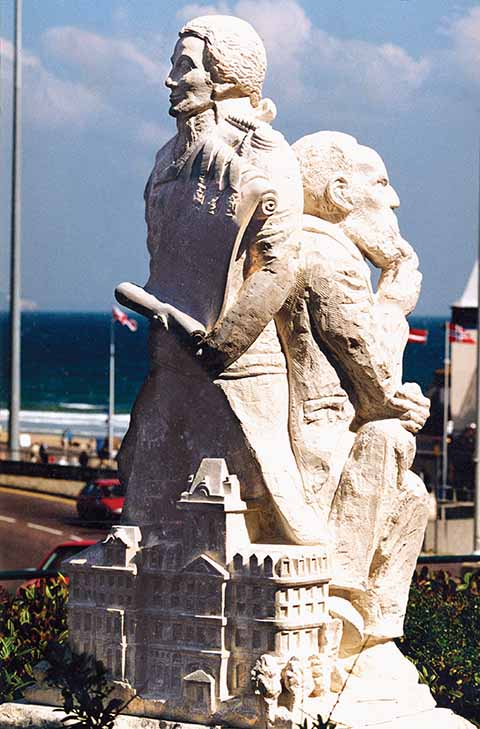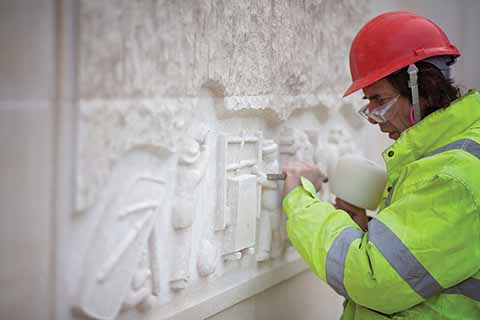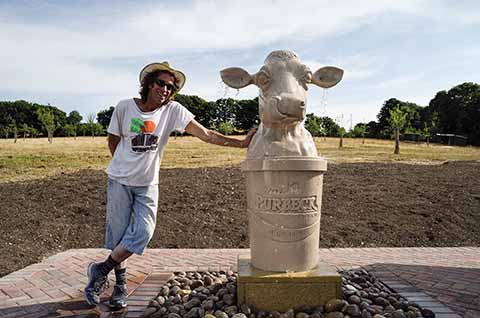Dorset artist – Seeing through stone
Lorraine Gibson talks to sculptor Jonathan Sells about his life and work
Published in July ’19
Imagine being born with cerebral palsy which goes unrecognised and ignored until much later, when you are an adult. This is what happened to Jonathan Sells. As a result, his childhood was a constant struggle with associated issues: impaired hearing, slurred speech and uncontrollable body movements. Worse, he had to cope in a mainstream school where he stood out like a sore thumb. ‘It was terrible,’ he recalls now. ‘I was belittled and degraded. The kids called me names and mocked me. I felt so out of place, like an alien, and it made me angry; I didn’t behave well.’
Teachers barely tolerated him. ‘It was impossible to conform and, aside from one teacher who made time for me, the others were sadistic. They wrote me off. I hated school so much that I’d play truant or pretend to be ill, anything, just so that I could stay away. Thankfully, my mum was very supportive.’

Jonathan’s sculpture behind the BIC commemorates Bournemouth founder Lewis Tregonwell and Christopher Creeke, the man who was surveyor to the Bournemouth Commissioners. He it was who addressed the issues of refuse and sewerage. His posture reflects Jonathan Swift’s aphorism that ‘men are never so serious, thoughtful, and intent, as when they are at stool’. He is sitting on a WC.
But, as is often the case, adversity led to a solution and the days Jonathan spent at home ‘ill’ turned out to be his salvation. He had time on his hands and those hands discovered Plasticine. ‘I spent hours playing with it. Modelling it into animals, people, objects, suddenly I had an outlet. At the age of seventeen, I bought a plaster of Paris mould set of Jeremy Fisher because I loved frogs. As soon as I scratched the plaster, I was hooked.’
This was the turning point. After being told he would get nowhere in life due to his lack of attention and poor behaviour, Jonathan finally found something he could do and do well. Using his fingernails, household utensils, anything he could, he proceeded to gouge, claw and carve like a thing possessed. Those first early efforts, including a couple of small and surprisingly accomplished mother-and-child pieces, still sit alongside more recent pieces in his dust-smothered studio. ‘I didn’t realise it then, but in hindsight, I think these are tributes to my mother’s love. Much of my motivation for doing art came from wanting to make her proud of me. When she died in 2007, I felt I’d lost my reason for continuing, but I started again. I’m glad I did.’
So are those who get to appreciate Jonathan’s many landmark works dotted around the county and beyond. Mainly hewn from his beloved Purbeck or Portland stones, the bold, large, often humorous, always thought-provoking pieces reflect Dorset lives and surroundings. His Portland stone Wareham Market statue, now at Cottees in Poole, stands eleven feet high and celebrates 700 years of the market’s existence. Outside the Bournemouth International Centre, his sardonic Tregonwell/Creeke piece has the town’s founding fathers perched atop the town hall, contemplating their legacy. Tregonwell looks smug, while Creeke appears lost in thought.
At Christchurch Priory, his humorous take on history is evident in his towering, commemorative work, nine feet six inches feet high, which was selected from a range of ideas submitted by 26 sculptors and shows several tongue-in-cheek depictions of famous figures, including Ranulf Flambard, Bishop of Durham, who planned the building of the priory in 1094.
To see Jonathan’s talent on a really grand scale, head to Portland’s Osprey Quay, part of the Portland Aldridge Community Academy, where a huge panel, influenced by designs from children from Underhill School, has pride of place. But his quirkiest piece by far has to be the cow fountain, recently commissioned by Purbeck Ice Cream near Kingston to celebrate its 30th anniversary. ‘The brief said “giant ice cream pot”,’ says Jonathan, ‘so I suggested we make it a bit more interesting and add a cow. They liked the idea and when I mentioned making it a fountain, they liked the idea, but drew the line at milk pouring out of its ears, though!’
Jonathan continues: ‘It’s difficult to explain, but I look at a stone and, in my mind’s eye, I can usually see exactly what it will become, before I’ve even lifted a tool.’ He grabs a chunk of Portland stone, roughly the size and shape of a kettle and says: ‘I see a man’s face, there’s his hat and his beard.’ When he says it, you see it, too.
The Purbeck-based sculptor, with his wrap-around shades and halo of unruly hair, may look more rock star than rock carver, but behind the sunglasses is an artist who ‘reads’ the local stones in order to work out what he will create from them. ‘Sometimes it’s just a vague image, other times it jumps right out at me and I know what it has to be.’ Pointing to a large, humped rock, one of many lying around outside his Corfe workshop, he says: ‘Dragon’ and, sure enough, there’s the hint of the sleeping monster he will set free. He is living proof of Michelangelo’s famous dictum: ‘Every block of stone has a statue inside it and it is the task of the sculptor to discover it.’
Not all his work is carved from stone, though: his beautifully tactile Yew Heart sculpture in the Royal Bournemouth Hospital’s charity Petal Garden is testament to his wood-carving skills.
Jonathan lives for his work and can talk about it for hours. The success of his public and private commissions and his teaching work has taken him a long way from the bullied lad who was told he would amount to nothing. Yet his past is what drives him and inspires him to work with disadvantaged and young people, teaching them that art is a wonderful outlet for talent. He has worked with partially-sighted people; he has helped school children create sculptures in just a day; for eleven years he worked once a week in a psychiatric hospital, encouraging depressed patients to take up art. ‘Suddenly they had something that was interesting and immediate. A lot of them were amazed at the end of the sessions, not just because they’d produced something worthwhile, but because they’d been so engrossed, they’d completely forgotten to go for a smoke!’
Much of his work is physically exhausting, but he does it despite some health issues he still carries in adulthood. He is in constant pain but the speech defect has been worn away, like the edges of his stones, by elocution lessons, the deafness has been improved with devices and his twitching had ceased when he took hold of his first proper carving tools at the age of seventeen.
Each job is challenging, but that’s what makes him tick. And the sunglasses? His condition makes him sensitive to very bright light. So more rock tsar than rock star, perhaps.
www.jonathan-sells.com



